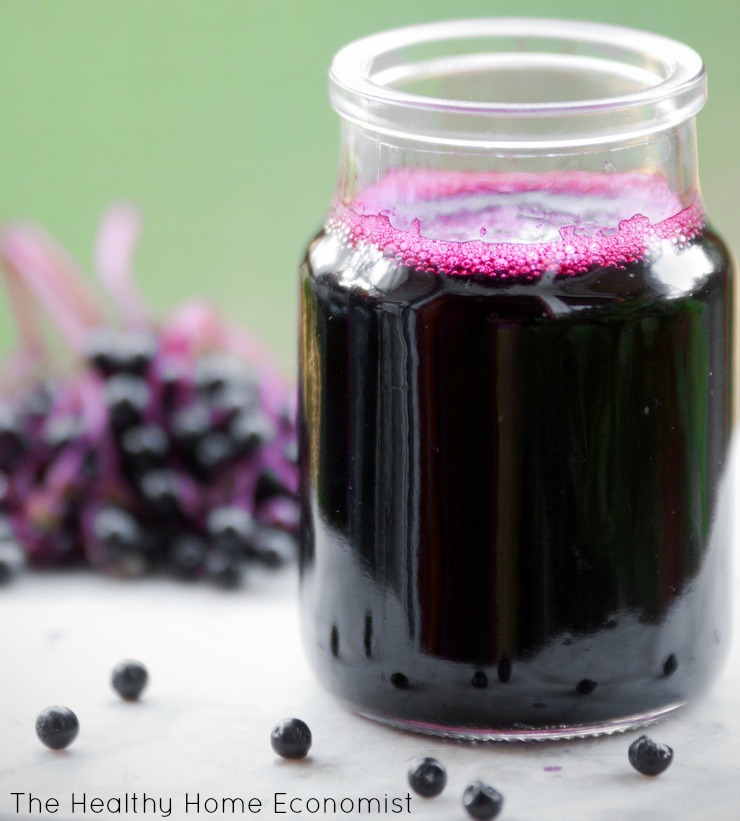
I’ve been using elderberry syrup to boost my family’s immunity for many years. This traditional remedy is a highly effective preventative as it is loaded with antioxidants, Vitamin C and immune-supporting minerals.
Elderberry is an essential must-have in the holistic medicine cabinet throughout the school year and during cold/flu season!
In addition to its benefits as a preventative, elderberry syrup helps get you well faster if you are already sick. This is particularly true with anything that is cough or sinus related.
This rich, dark, tasty syrup (kids love it!) was a key part of my strategy for my children during a bout with pertussis (whooping cough) 10 years ago. In fact, it is one of the very few remedies that are helpful for this ailment.
With anything that is beneficial, however, there seems to be a downside to watch out for. Have you noticed this too?
With elderberries specifically, this caution is with regard to how the syrup is made.
Raw Elderberry Dangers
Recently, I’ve received some emails regarding my 3-ingredient, ultra-simple recipe for homemade elderberry syrup which uses cooked elderberries. These emails from readers promoted a different recipe that does not cook the berries first.
These emails suggesting an uncooked syrup stated that keeping the elderberries raw preserved enzymes and the natural acidophilus probiotic on the berries and leaves themselves and that this was beneficial to improving the syrup to a more potent level.
While elderberry enzymes and probiotics are definitely retained if you make raw elderberry syrup, there are significant risks to this approach.
Raw is not always better! The humble elderberry is a very good example of this.
Elderberry is Highly Astringent
The elderberry is a highly astringent plant. What this means is that it contains compounds that can cause severe contraction of body tissues either internally or externally. The fresh leaves, flowers, bark, unripe berries, unripe buds, and roots of the elderberry contain a bitter alkaloid and also a glucoside that, under certain conditions, can produce hydrocyanic acid (prussic acid) which is poisonous.
The astringent qualities of elderberries lessen as the fruit ripens. Most importantly, these anti-nutrients are deactivated when elderberries are cooked. Cooking the berries first before making the syrup also has the benefit of enhancing the unique flavor of the elderberry.
While elderberries are safe to consume if cooked, consuming uncooked berries or their juice may produce nausea or more severe symptoms. When the leaves or stems are crushed with the berries, the risk for an adverse reaction is even greater.
Hence, when you are making elderberry syrup yourself, it is important to always avoid picking unripe elderberries or including the leaves or parts of the stem.
How to Tell if an Elderberry is Safe or Dangerous
When elderberries are unripe, they are greenish. Berries of similar species are red. When elderberries are ripe and ready to be picked usually during July and August in North America (except the Pacific Northwest), they are dark and purple to blue-black in color. According to the USDA:
Only the blue or purple berries of elderberry are edible. Edible berries and flower are used for medicine, dyes for basketry, arrow shafts, flute, whistles, clapper sticks, and folk medicine. The active alkaloids in elderberry plants are hydrocyanic acid and sambucine. Both alkaloids will cause nausea so care should be observed with this plant. Elderberries are high in Vitamin C. The red berries of other [related] species are toxic and should not be gathered (1).
To make sure you are getting ripe elderberries if you prefer not to forage for them yourself, you can source quality berries from a reliable herbal manufacturer. Incidentally, if knowing how to safely forage for food plants is of interest to you (like it is to me), Foraging and Feasting: A Field Guide and Wild Food Cookbook is a wonderful primer.
Health Risks from Elderberry if Raw
It alarms me greatly when I receive emails from people that they are making raw elderberry syrup. If completely ripe berries were not used or if some leaves or bits of stem were included in making the syrup either accidentally or intentionally, this mistake could send your child to the emergency room.
One example of how raw elderberry juice is dangerous occurred on a California retreat. Eight people ended up hospitalized for various symptoms (2). Retreat staff had gathered local, wild elderberries and pressed them into juice for the group, mixing it with apple juice and sugar which disguised the bitter, astringent qualities of the elderberry.
Within 15 minutes of consuming the juice mixture, retreat attendees began to suffer from acute gastrointestinal and neurologic symptoms which included nausea, vomiting, abdominal cramps, and weakness. Some also complained of dizziness and numbness. One individual experienced a state of severe stupor.
Cooking Elderberries First is the Safest Way to Make Syrup
In sum, due to the risks of consuming raw elderberries, it is the safest approach, in my opinion, to cook them first. This is especially recommended if the syrup will be used with young children or those with digestive issues.
Note that if you choose to use commercial elderberry juice concentrate (this brand is excellent) to make syrup, it has already been heated from processing and is thus safe to consume without cooking.
Try making this recipe for elderberry jello as a fun and safe way to enjoy this immune-boosting food.








Updates to research say otherwise. I have an elderberry farm and work closely with the Missouri University Extension. There has been research recently that has shown that there is no risk of cyanide in elderberries. https://www.mdpi.com/1420-3049/26/5/1384 It is true that most people will tolerate elderberry better if it has been either fermented or cooked. I have the same problem with raw apples or pears, they give me cramps and bloating. A serving size of elderberry is no more than a 1/4 cup, many see benefits with just 1 tablespoon. Weeat raw elderberry to determine ripeness and well, just because! We hear so many things about elders that well, often are based on folklore.
Heat or no heat when using alcohol to make tincture? Does the alcohol negate the toxins if using fresh ripe berrys? Any articles or studies to direct me to? Slow poisoning is still poisoning so just because there arent any obvious instant effects, doesn’t mean its not affecting us negatively. I just want to be 100% sure and safe with verifiable facts. Thanks
I thought when you said, how to test if your elderberries are safe, give it to your cat. LOL! Just kidding, of course.